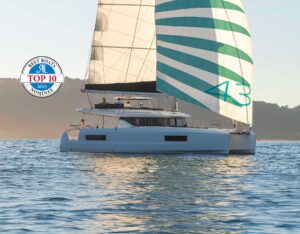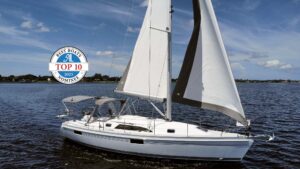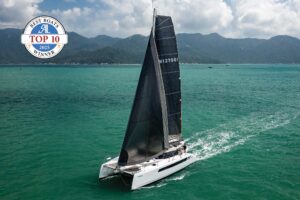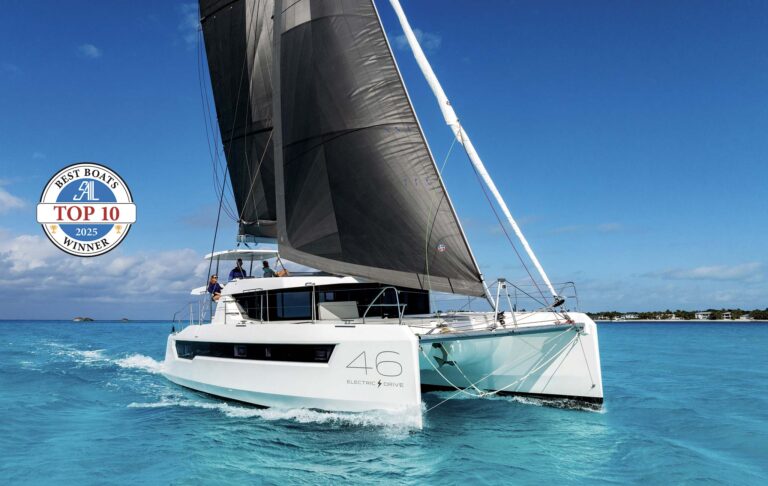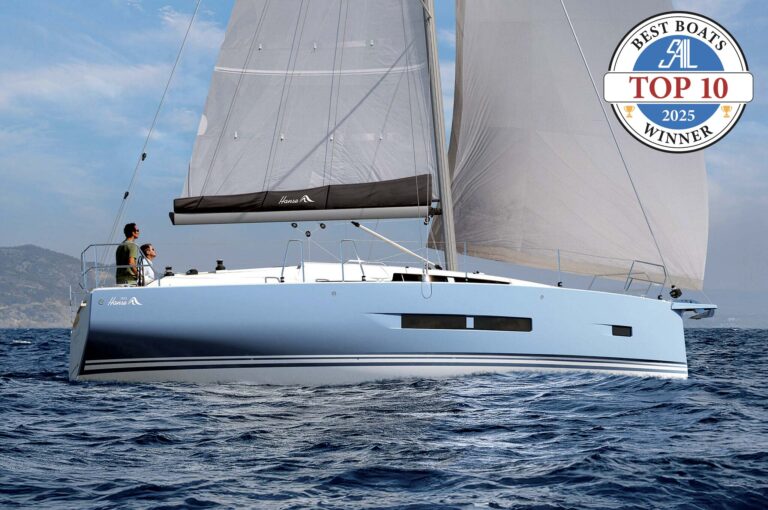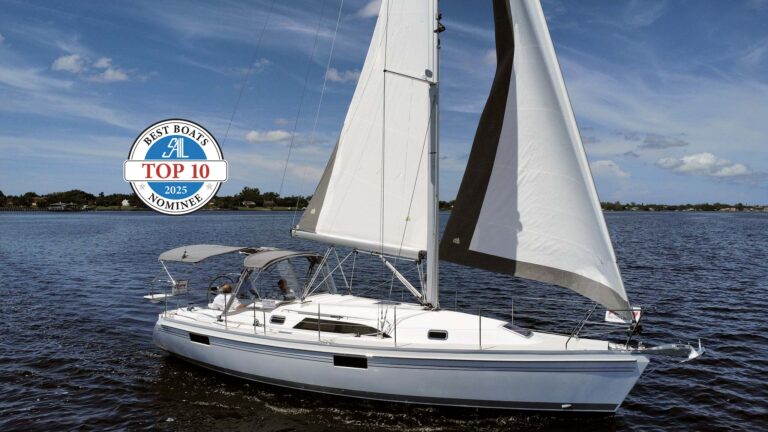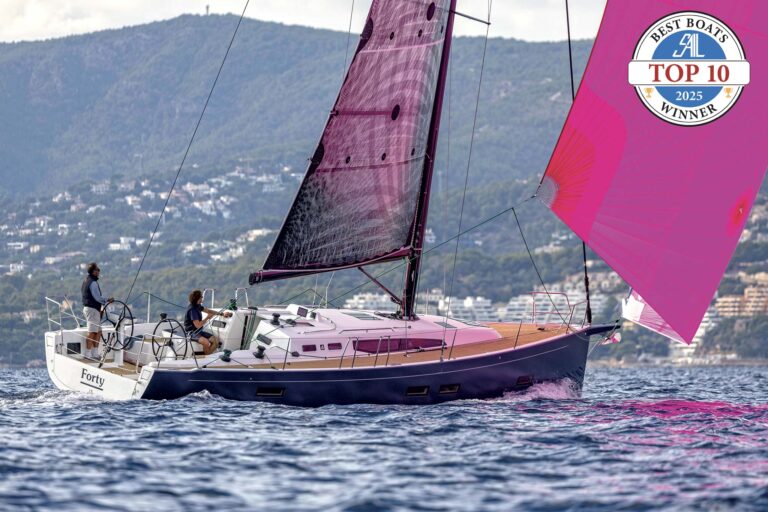
The new J/122, a 40-foot cruiser/racer, was designed by Alan Johnstone of the legendary J/Boats family and is being built in France by J/Europe. Its sporty credentials include light-to-moderate displacement (14,900 pounds), minimal overhangs, and a slippery, flat-bottomed hull form. A swept-back double-spreader Hall Spars carbon-fiber rig and a retractable carbon-fiber bowsprit are standard; the removable “dock box” that seals off the open transom is an option.
CONSTRUCTION
Hull and deck are molded using the SCRIMP resin-infusion system, with end-grain balsa (hull) and foam (deck) sandwiched between skins of E-glass and vinylester resin. The hull-deck joint is an inward-turning flange; bulkheads are laminated to the hull and deck. The iron keel fin carries a lead bulb. The boat comes with a 10-year osmosis warranty and a 5-year structural warranty.
DECK AND COCKPIT
The cockpit was designed with performance sailing in mind. Two foot braces are integrated into the cockpit floor behind the big wheel; forward of it is a flush-mounted 6:1 traveler (easy to step around and adjust, even when the boat is loaded up). There are two big side lockers and another in the sole abaft the wheel. Most deck gear is by Harken. Halyards and reefing lines are led aft to the cabintop and are nicely organized with Spinlock XCS rope clutches and dual Harken 44.2 STA halyard winches. The 2:1 end-boom mainsheet is controlled via dual Harken 46.2 STA mainsheet winches; genoa sheets are trimmed with Harken 48.2 STA primary winches. The cabintop sports stainless-steel handrails, and the molded fiberglass toerails on the foredeck are IRC-legal. The furling drum for the headsail (100 percent for cruising, 110 percent for racing) is belowdeck, enabling the boat to carry a headsail with a lower tack.
ACCOMMODATION
A three-cabin, single-head layout is standard; a more-traditional optional cruising layout includes two cabins and two heads. A synthetic, light-colored antiskid sole, mahogany woodwork and bulkheads, and molded white wood hull lining give the interior a light, airy feel. A removable molded, modular headliner makes it easy to access deck fittings. Fiddles and handrails are where you want them for rough-weather sailing, cabin doors are cored and insulated, and all cabinets are secured with push-button latches. The hatches have retractable bug screens. Stowage in the cabins is generous. The saloon settees are parallel to the boat’s centerline, with stowage outboard and fuel and water tanks located below. The efficient U-shaped galley has ample stowage and worktop space, and there are plenty of handrails and fiddles for meal preparation under way. Both layouts have a forward-facing nav station situated to port.
UNDER SAIL
We easily made low-to-mid 7 knots of boatspeed sailing to weather in 8.5 to 9 knots apparent, and the boat proved capable of sailing tight angles. Off the wind, we easily made 9.1 to 9.3 knots with the kite up in a freshening breeze of 11 to 13 knots. Flying and gybing the A-sail (with a crew of three) was easily done from the cockpit. The boat had a crisp, stiff feel and is exceptionally well balanced. I experienced almost no weather helm sailing upwind, even with the boom a few inches above centerline and no weight on the rail. The boat has clean sight lines from multiple helm positions, and the foot braces are well positioned. Since all sail controls are led back to the cabintop, reefing (via a two-line setup) is a snap. The carbon-fiber rig has a wide shroud base, (the jib sheets inside the shrouds).
UNDER POWER
We had no trouble making 8+ knots at 2,200 RPM with the standard Volvo D2 40-horsepower saildrive. The boat has a tight turning radius under both sail and power and maneuvers easily, even in a tight mooring field or at a busy fuel dock.
VITAL STATISTICS
HEADROOM: Saloon 6’4″, aft cabin, 6’3″, forecabin 6’2″ » BUNKS: Aft double(s)
6’6″×4’6″, forward double 6’6″×5 »
SETTEES: 6’6″×2’2″ (backrest removed) » COCKPIT: 12’3″×6’5″ » HANDICAP RATINGS (IRC/PHRF): 1.096-1.010/36-39
SPECIFICATIONS
Price: $369,000 (FOB Warren, Rhode Island),
excludes electronics, sails, and commissioning.
Builder: J/Europe of Les Sables
d’Olonne, France
Designer: Alan Johnstone
LOA: 40′ » LWL: 34’6″ »
Beam: 11’9″ » Draft: 7’2″
Displacement: 14,900 lbs » Ballast: 5,600 lbs
Sail Area (100% foretriangle): 876 sq ft
Tankage: (fuel/water/waste) 35/42/16
Electrical: (1) 70 amp; (2) 80 amp
Displacement-Length Ratio: 161
Sail Area-Displacement Ratio: 23
Ballast Ratio: 37.6%
OUR TAKE
PROs:
- Easy to switch from racing to cruising mode, thanks to the removable “dock box”
- Easy to sail kites shorthanded
CONs:
- Lacks tankage for long-distance cruisingCONCLUSION:
Over all, the J/122 is likely to become a potent racecourse performer on the IRC and one-design circuits; it should also do well in PHRF fleets. It’s a lot of boat with possibilities for either a performance-minded offshore cruiser or a veteran racer.

